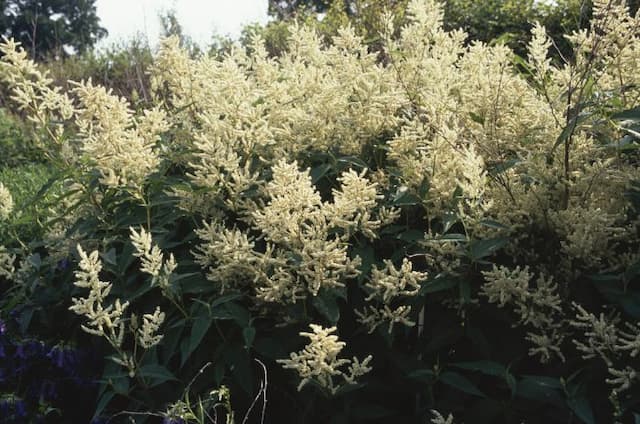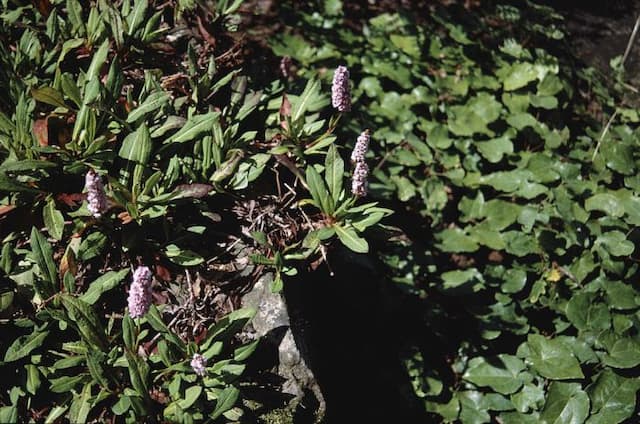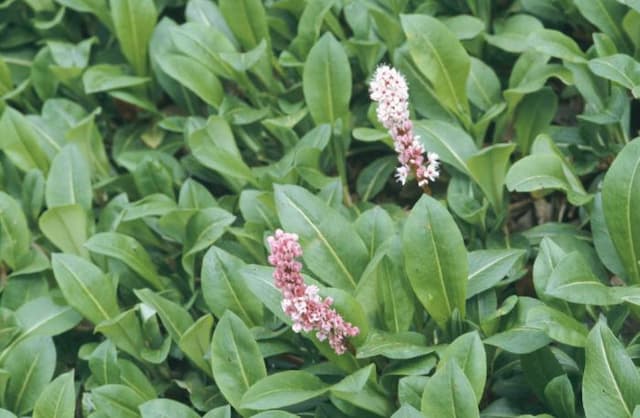Rhubarb Rheum × hybridum

ABOUT
The plant known as rhubarb is characterized by its large, broad leaves which are typically heavy and dark green with reddish or light green coloration depending on the variety. These leaves often have pronounced ribs and veins, enhancing their textured appearance. The underside of the leaves may have a lighter green hue. Coming out from the base, you can find thick, fleshy stalks that are most commonly recognized for their red hue, although some plants can have green or pinkish stalks. These stalks support the large leaves and are often harvested for culinary use due to their tart flavor. In its flowering season, rhubarb produces tall, clustered flower stalks that hold small white or pinkish flowers. The overall appearance of rhubarb plants is lush and vivid, with the contrast of dark leaves and brightly colored stalks standing out in garden settings.
About this plant
 Names
NamesFamily
Polygonaceae.
Synonyms
Garden Rhubarb, Culinary Rhubarb, Pieplant, Rhubarb.
Common names
Rheum × cultorum, Rheum rhabarbarum.
 Toxicity
ToxicityTo humans
Rheum × hybridum is commonly known as rhubarb. The leaves of rhubarb contain oxalic acid and anthraquinone glycosides, which are toxic if ingested in large quantities. Eating rhubarb leaves can cause poisoning characterized by symptoms such as burning sensation in the mouth and throat, nausea, vomiting, abdominal pain, and diarrhea. In severe cases, symptoms may progress to include difficulty breathing, seizures, and kidney failure due to the oxalic acid binding with calcium in the body. It is important to only consume the stalks of the rhubarb plant as they are edible and safe when cooked.
To pets
Rhubarb (Rheum × hybridum) is also toxic to pets for the same reasons it is to humans. The leaves contain oxalic acid and anthraquinone glycosides that can lead to poisoning. If pets ingest rhubarb leaves, they may experience symptoms such as drooling, loss of appetite, vomiting, diarrhea, lethargy, and abdominal pain. More serious cases can result in tremors, seizures, and kidney failure. It's crucial to prevent pets from accessing any part of the rhubarb plant aside from the stalks, which are typically not considered toxic.
 Characteristics
CharacteristicsLife cycle
Perennials
Foliage type
Deciduous
Color of leaves
Green
Height
2-3 feet (0.6-0.9 meters)
Spread
3-4 feet (0.9-1.2 meters)
Plant type
Herb
Hardiness zones
3-8
Native area
Asia
Benefits
 General Benefits
General Benefits- Nutritional Content: Rheum × hybridum, commonly known as rhubarb, is rich in vitamins such as vitamin K and vitamin C, and dietary minerals including calcium and potassium.
- Dietary Fiber: Rhubarb is a good source of dietary fiber, which helps in maintaining good digestive health.
- Low in Calories: Rhubarb is low in calories, making it a suitable food for weight management diets.
- Culinary Versatility: Rhubarb can be used in a variety of sweet and savory dishes, including pies, crumbles, and sauces, providing a tart flavor that complements other ingredients.
- Garden Aesthetic: With its large leaves and vibrant stalks, rhubarb can serve as an ornamental plant, adding visual interest to gardens.
- Easy to Grow: Rhubarb is relatively easy to cultivate in a range of climates, making it accessible for home gardeners.
- Perennial Growth: As a perennial plant, rhubarb will regrow every spring once established, without needing to be replanted annually.
 Medical Properties
Medical Properties- Laxative effect: Rheum × hybridum, commonly known as rhubarb, contains compounds such as anthraquinones that have a laxative effect and can be used to treat constipation.
- Anti-inflammatory properties: It has been reported to have anti-inflammatory effects, which could be helpful in reducing inflammation.
- Antioxidant activity: Rhubarb contains antioxidants which may help in protecting cells from damage caused by free radicals.
- Digestive health: Traditionally, rhubarb has been used to aid digestion and promote gastrointestinal health.
 Air-purifying Qualities
Air-purifying QualitiesThis plant is not specifically known for air purifying qualities.
 Other Uses
Other Uses- Rheum × hybridum, commonly known as Rhubarb, can be used to create a natural dye for fabrics and yarn, where the roots provide a deep, rich color.
- In the garden, Rhubarb can be interplanted with other crops to deter pests with its strong aroma and large leaves, acting as a natural pest repellent.
- Rhubarb leaves can be placed in compost piles, where they contribute to the nutrient content and decompose well due to their high water content.
- The large leaves of Rhubarb can be used to create a natural leaf mold. Over time, the leaves break down into a rich, crumbly compost that is excellent for soil conditioning.
- An eco-friendly Rhubarb leaf mold can also serve as a mulch material for gardens, helping to retain soil moisture and suppress weeds.
- The strong fibers found in Rhubarb stalks have potential use in making paper or crafting biodegradable materials.
- Historically, Rhubarb has been used for cleaning pans and pots due to its abrasive texture which can help scrape off burnt food.
- Artists may use the stalks of Rhubarb as natural paintbrushes for textural painting and experimental art techniques.
- The high oxalic acid content in Rhubarb leaves gives them potential use as a mordant in the process of fixing dyes on fabrics.
- Rhubarb's dramatic appearance and large leaves can be employed as a natural backdrop in theatrical sets or as a prop in storytelling and play.
Interesting Facts
 Feng Shui
Feng ShuiThe rhubarb is not used in Feng Shui practice.
 Zodiac Sign Compitability
Zodiac Sign CompitabilityThe rhubarb is not used in astrology practice.
 Plant Symbolism
Plant Symbolism- Vitality: Rhubarb's vigorous spring growth symbolizes vitality and renewal.
- Protection: Its large leaves were believed to protect against evil spirits in some cultures.
- Provision: The plant's edibility and medicinal properties represent sustenance and the provision of necessities.
- Resilience: Rhubarb's ability to thrive in cool climates symbolizes strength and resilience against harsh conditions.
- Change: As rhubarb is among the first plants to sprout in spring, it represents change and new beginnings.
- Reflection: The historical use of rhubarb roots for dyeing suggests a symbolic meaning of introspection and self-examination.
 Water
WaterThe common name for Rheum × hybridum is rhubarb, and it should be watered deeply whenever the top inch of soil feels dry to the touch. This typically means watering once a week, but the frequency can vary depending on temperature and humidity levels. Provide enough water to soak the soil to a depth of at least 6 inches, which might equate to about 1 to 2 gallons for a mature plant. During hot and dry spells, watering may need to be increased. Always avoid overhead watering to prevent leaf diseases and instead direct water to the base of the plant.
 Light
LightRhubarb thrives in full sun, which means it needs at least six hours of direct sunlight each day. Position rhubarb in a spot in the garden where it can enjoy unfiltered sunlight. Too much shade will result in weak stems and reduced harvest. If you're growing rhubarb in a particularly hot climate, some afternoon shade can help prevent the plant from bolting.
 Temperature
TemperatureRhubarb performs best in temperate climates, with ideal growing temperatures ranging from 60°F to 75°F. It can tolerate a maximum temperature of around 90°F and a minimum temperature down to about 20°F without active growth. Rhubarb requires a period of winter chilling with temperatures between 32°F and 40°F to produce a good crop.
 Pruning
PruningPruning rhubarb primarily involves removing flower stalks as soon as they appear to encourage the plants to focus their energy on producing large, healthy stalks. Additionally, remove any dead or damaged leaves throughout the growing season. The best time for pruning rhubarb is throughout the harvest period, which is from late spring to early summer.
 Cleaning
CleaningAs needed
 Soil
SoilRheum × hybridum, commonly known as rhubarb, thrives in fertile, well-drained soil with a pH between 5.5 and 6.5. The best soil mix should be rich in organic matter like compost, peat, and well-rotted manure to provide the nutrients rhubarb needs for growth.
 Repotting
RepottingRhubarb doesn't require frequent repotting as it is typically grown in the ground. If grown in containers, rhubarb should be repotted when it outgrows its pot, which may be every 4-5 years, to ensure enough space for its large root system.
 Humidity & Misting
Humidity & MistingRhubarb (Rheum × hybridum) does not have specific humidity requirements as it is a hardy outdoor plant. It is generally tolerant of the ambient outdoor humidity levels in the regions where it can be successfully cultivated.
 Suitable locations
Suitable locationsIndoor
Ensure large pot, rich soil, adequate water, and sunlight.
Outdoor
Plant in fertile soil, full sun, provide space to grow.
Hardiness zone
3-8 USDA
 Life cycle
Life cycleThe life of Rhubarb (Rheum × hybridum) begins with seed germination, where the seed must be stratified (chilled) to break dormancy and then sown in warm soil to sprout. The seedlings grow rapidly and can be transplanted to their final growing location where they develop large leaves and thick, edible petioles (stems). Over the first few years, rhubarb focuses on vegetative growth, establishing a strong root system. Following the vegetative stage, rhubarb reaches maturity and can begin to produce flowers and seeds in subsequent years; however, flowering is often undesirable for cultivation as it can reduce the quality and quantity of the edible stems. Rhubarb is a perennial plant, capable of surviving winters to regrow in the spring for several years, with a productive lifespan of around 10 to 15 years. After its productive years, the plant's vigor diminishes, and it will eventually die, completing its life cycle.
 Propogation
PropogationPropogation time
Spring-Summer
Propogation: Rheum × hybridum, commonly known as garden rhubarb, is often propagated by crown division, which is its most popular method of propagation. This process is typically done in early spring before the plant breaks dormancy, or in the fall after the leaves have died back. To propagate by division, gardeners dig up the entire rhubarb plant, ensuring that they keep as many roots intact as possible. The crown of the plant, which includes the upper part of the roots and the growing points, is then cut into several pieces, each with at least one strong bud. The sections are replanted at a depth where the top of the crown is just at or slightly below the soil surface, spaced about 3 to 4 feet apart to allow ample room for growth. Care should be taken to water these newly planted divisions regularly, allowing them to establish a robust root system.

![Red bistort [JS Seven Oaks Village]](/_next/image?url=https%3A%2F%2Fplants-admin.emdemapps.com%2Fimages%2Fplants%2F%2Fimages%2F604b56557c0e3.png&w=640&q=75)







